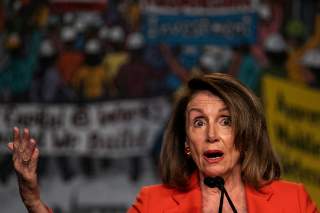$2 Trillion for Infrastructure: How Do You Pay For It?
Taxpayers are going to find out.
President Donald Trump and a delegation of congressional Democrats agreed Tuesday on “big and bold” infrastructure plans with an equally big price tag of $2 trillion over 10 years.
The discussion of how to pay for it was left for another day.
Democratic leaders noted it would include expanding broadband internet access and work on the nation’s power grid, in addition to road construction.
Senate Minority Leader Charles Schumer, D-N.Y., said there was much “good will” from the meeting with the president, a marked departure from previous meetings where illegal immigration was discussed.
“We agreed on a number. This is very, very good: $2 trillion for infrastructure,” Schumer told reporters after the meeting at the White House. “Originally, we started lower. Even the president was eager to push it up to $2 trillion.”
In three weeks, members of Congress will meet again with the president to discuss how they would pay for the big-ticket plans.
White House press secretary Sarah Huckabee Sanders, while not repeating the price tag cited by Democrats, noted bipartisan agreement in the meeting.
“The United States has not come even close to properly investing in infrastructure for many years, foolishly prioritizing the interests of other countries over our own,” Sanders said in a statement.
“We have to invest in this country’s future and bring our infrastructure to a level better than it has ever been before. We will have another meeting in three weeks to discuss specific proposals and financing methods,” she added.
Five other Democratic senators and five other Democratic House members joined Schumer and House Speaker Nancy Pelosi, D-Calif., in the meeting with Trump and other administration officials.
Pelosi said, “We did come to one agreement, that the agreement would be big and bold.”
“It’s about jobs, jobs, jobs. It’s about promoting commerce. It’s about clean air and clean water. It’s a quality-of-life issue, of cars not being on the road so much, and in every way it is a safety issue,” she said.
But the proposal’s huge price tag drew immediate fire from the fiscally conservative free-market advocacy group Americans for Prosperity, CNBC reported.
“If Congress wants to find money to modernize our roads and bridges, we encourage them to look to their own pockets. Americans have been filling them up for years,” said Brent Gardner, the group’s head of government affairs. “Instead of proposing a $2 trillion catch-all ‘infrastructure’ bill and asking hardworking Americans to fund it by paying more at the pump, Washington lawmakers should cut the red tape and stop wasting the tax dollars we give them.”
This article by Fred Lucas originally appeared at The Daily Signal. This article first appeared in 2019.
Image: Reuters

